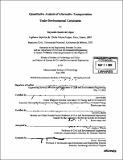| dc.contributor.advisor | john Reilly and David H. Marks . | en_US |
| dc.contributor.author | Sandoval López, Reynaldo | en_US |
| dc.contributor.other | Massachusetts Institute of Technology. Dept. of Civil and Environmental Engineering. | en_US |
| dc.date.accessioned | 2006-11-07T16:49:45Z | |
| dc.date.available | 2006-11-07T16:49:45Z | |
| dc.date.copyright | 2006 | en_US |
| dc.date.issued | 2006 | en_US |
| dc.identifier.uri | http://hdl.handle.net/1721.1/34661 | |
| dc.description | Thesis (S.M.)--Massachusetts Institute of Technology, Engineering Systems Division, Technology and Policy Program; and, (S.M.)--Massachusetts Institute of Technology, Dept. of Civil and Environmental Engineering, 2006. | en_US |
| dc.description | Includes bibliographical references (leaves 74-75). | en_US |
| dc.description.abstract | This thesis focuses on the transportation sector and its role in emissions of carbon dioxide (CO2) and conventional pollutant emissions. Specifically, it analyzes the potential for hydrogen based transportation, introducing this technological option within a computable general equilibrium (CGE) model of the economy. The transportation sector accounts for an important part of CO2 emissions and analyses that have imposed carbon limits on the economy have shown relatively limited reductions in transportation emissions with current technology, thus the interest in technological options that would make it economic to reduce emissions. The US Federal government has been particularly focused on developing fuel cell technology for vehicles that, when powered by hydrogen, would offer a technological solution that potentially eliminates emissions of both CO2 and other conventional pollutants from the transportation sector. This work examines the economic conditions under which such a technology might successfully compete in the market. The thesis begins with an overview of the fuel-cell vehicle technology and the technologies used to produce hydrogen. This review serves as a basis for modeling this technological option. | en_US |
| dc.description.abstract | (cont.) The main conclusions are the following: * Under market conditions and in the absence of climate policy that would price carbon, hydrogen fuel cell vehicles penetrate the USA market when the cost of vehicles is no more than 1.30 times the cost of conventional vehicles, and assuming hydrogen can be produced at 1.30 times the 1997 price of gasoline. Even if this cost target is reached and hydrogen vehicles enter the market, CO2 emissions for the US are reduced only very slightly because coal is used to produce the hydrogen and there is no incentive to sequester the carbon when the hydrogen is produced. * The existing fuel tax structure in Europe strongly favors the entry of hydrogen transportation, even when hydrogen is taxed at the same rate as gasoline. This is because the hydrogen vehicles are more efficient, and assuming the tax rate is per unit of energy, this implies a lower tax per vehicle mile traveled. Entry is possible in the middle of the century when hydrogen vehicles are twice as expensive as conventional ... | en_US |
| dc.description.statementofresponsibility | by Renaldo Sandoval López. | en_US |
| dc.format.extent | 75 leaves | en_US |
| dc.format.extent | 2827952 bytes | |
| dc.format.extent | 2831022 bytes | |
| dc.format.mimetype | application/pdf | |
| dc.format.mimetype | application/pdf | |
| dc.language.iso | eng | en_US |
| dc.publisher | Massachusetts Institute of Technology | en_US |
| dc.rights | M.I.T. theses are protected by copyright. They may be viewed from this source for any purpose, but reproduction or distribution in any format is prohibited without written permission. See provided URL for inquiries about permission. | en_US |
| dc.rights.uri | http://dspace.mit.edu/handle/1721.1/7582 | |
| dc.subject | Technology and Policy Program. | en_US |
| dc.subject | Civil and Environmental Engineering. | en_US |
| dc.title | Quantitative analysis of alternative transportation under environmental constraints | en_US |
| dc.type | Thesis | en_US |
| dc.description.degree | S.M. | en_US |
| dc.contributor.department | Massachusetts Institute of Technology. Department of Civil and Environmental Engineering | |
| dc.contributor.department | Massachusetts Institute of Technology. Engineering Systems Division | |
| dc.contributor.department | Technology and Policy Program | |
| dc.identifier.oclc | 71003480 | en_US |
